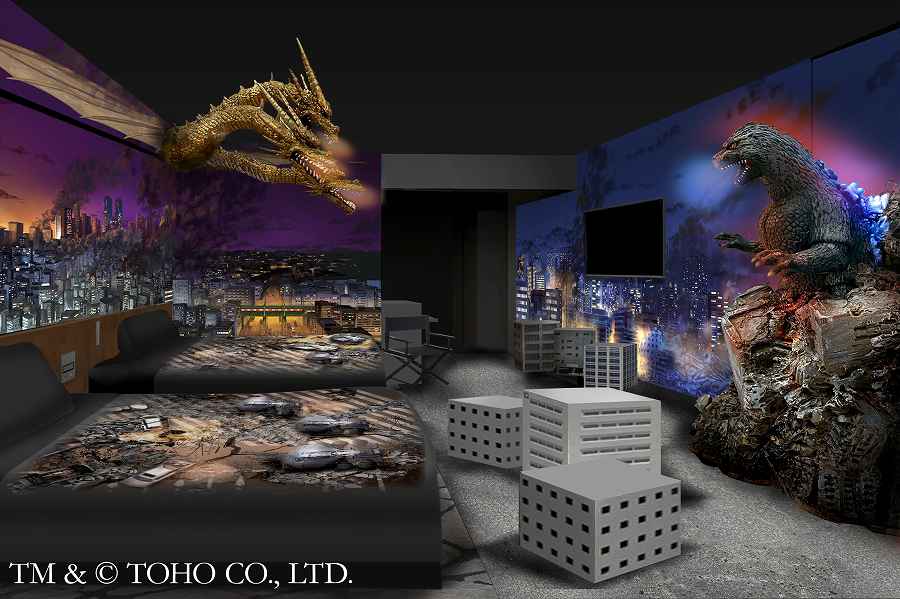
Hotel Gracery Shinjuku to Launch ‘Godzilla VS King Ghidorah Room’ on July 1
Over the past four installments, even though I’ve introduced what could be called the “luxury Nishinari hotels” of Osaka, ranging from 3,000 to 5,000 Yen per night, as a true fan of Nishinari, I felt a certain itchiness, a feeling of “this isn’t quite it”. The higher price tags, of course, afford great physical comfort for stays of two or three nights. However, something was just not quite right for me.
It’s not the fault of the hotels themselves. The inbound tourism market in Osaka has recovered, and not just Japanese visitors but also international tourists have been returning. There should be a clear distinction between high-end and low-end hotel accommodations.
Given these feelings, I decided to go back to the basics and chose a low-cost route for my latest visit to a Nishinari hotel.
The accommodation in question is “Business Hotel Fukusuke”, located right in the heart of Nishinari, south of the now-closed “Ailin Comprehensive Center”. The area today exudes a considerably safe atmosphere, but still, it’s a region where due caution regarding its Dobayashi-like characteristics is advisable.
The main reason I chose Fukusuke this time was because of its early check-in time. Astonishingly, check-in begins at 10:30 am (last check-in at 10 pm). Usually, when I go to Osaka, my morning begins with work in Tokyo, followed by a flight from either Haneda Airport or Narita Airport to either Osaka Airport or Kansai Airport, arriving around 1 pm. After that, I head directly to my interview locations, with check-in typically around 8 pm. But this time, thanks to a flight with LCC Peach, departing Narita at 8:30 am and arriving at Kansai Airport at 10:10 am, I decided to check in just after noon.
Upon arriving at Nankai Kansai Airport Line’s Shin-Imamiya Station a little after noon, the vicinity of the former “Ailin Comprehensive Center” was as usual inhabited by homeless individuals. The Osaka High Court issued an evacuation order for these homeless residents on December 14, 2022, but enforcement has not yet been carried out.
Passing by and turning right (south) at the third corner, I saw what appeared to be day laborers, who seemed not to be working that day, loitering around. Amidst a fleeting moment of quietness, I made my way to the hotel.
Despite my worries that check-in starting at 10:30 am might mean entering the room would only be possible in the evening, simply giving my name at the front desk quickly dispelled such concerns, and I was handed the key without issue. Really, it was surprisingly straightforward. I didn’t even have to fill in a registration card. (laughs)
Although I didn’t mention it in the series, I actually stayed at Fukusuke before the pandemic. At that time, a deposit (security deposit) of 500 Yen was required to receive the room key (returned upon key return), but that system has since been abolished (1,000 Yen fee in case of key loss). It seems for checkout, you just drop your key into a box in front of the front desk.
Previously, you had to remove your shoes at the entrance and walk around the hotel in slippers, which is still the case, but now there are shoe boxes labeled with room numbers, so you don’t have to carry your shoes to your room. This system doesn’t lock, so it’s at your own risk, but surveillance cameras are operating, so it’s probably fine (if anxious, it’s recommended to take your shoes to your room). The hotel is for men only. Non-smoking & smoking rooms. Foreign guests are probably non-existent. It’s not that they’re being rejected, but it’s almost all Japanese.
The guest rooms are on the 1st to 7th floors. This time, I was assigned a room on the 4th floor.
Exiting the elevator, there were some books on the hallway shelves. Unnecessary for a one-night stay, but could be useful for longer stays. The lighting was dim, and the orderly row of steel doors lent a Showa-era atmosphere, which was somewhat melancholic but maintained a feeling of cleanliness.
Upon turning the room key and entering, there was a tatami room of three mats (with shared toilet and bath), of course. It’s been a while since I’ve been in a tatami room — it’s “The Nishinari” indeed. I still have trauma from another hotel’s tatami room I stayed in before, where bugs kept appearing, but this hotel maintained its cleanliness, and everything was fine until checkout.
The cost for one night’s stay without meals is 1,700 Yen (tax included). There’s nothing to complain about the room itself.
A TV, refrigerator, and even a small table. There’s also a standalone air conditioner, and the ceiling light is bright.
Moreover, while many Nishinari hotels provide only two hangers, here there were three!
There is only one electrical outlet, but a power strip capable of accommodating three plugs was pre-installed. Free Wi-Fi is provided on each floor, and a test of the download speed yielded 280Mbps. This was much more comfortable than my home.
The only downside was that, though there’s a door viewer, it had no cover. As usual, I held it with a sticker.
I tried laying out the futon, and with three mats, there was plenty of space. Do you remember the 1.5 tatami room from “Hotel Diamond” that I introduced in the 4th installment? Compared to that, this was a comfortable space.
Having some time before heading to my interview locations, I went on my usual exploration of the hotel.